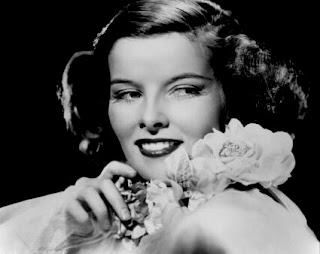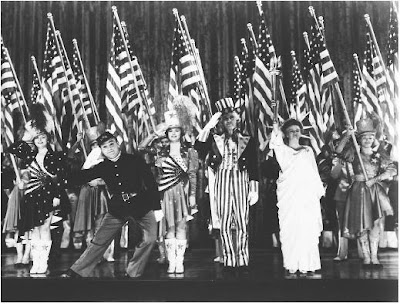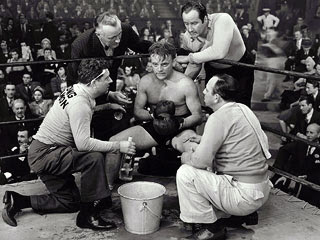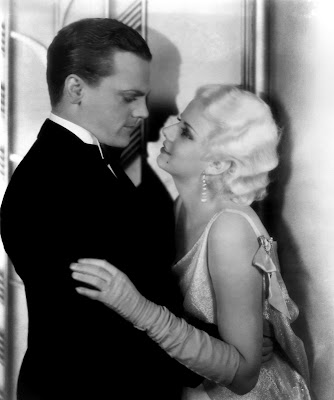James Cagney's many talents would help pave his
way to Hollywood.
In 1921, James Cagney and his girlfriend Willie Vernon were traveling around with different vaudeville troupes trying to save enough money to start a life together. There were highs and lows, but Jim was a determined guy devoted to doing whatever it took to earn money to keep himself and his family back home afloat. If that meant taking a job outside the entertainment business, he was fine with it. However, Willie always pushed him to pursue his stage talents, even if it cost them the extra dough. Every once and awhile, Jim would get a lucky leg up. One such opportunity was taking a gig with a trio that had just lost it's third member. Thus, the group Parker, Rand, and Cagney was born. Unfortunately, the comic trio did not fare well and reviews were poor. Apparently, the writing and gags were old hat and not very funny, which is perhaps why the original member had ducked out. Originally, the group had been called Parker, Rand, and Leach. James would later bump into Archibald Leach after both men had gone Hollywood and the latter had changed his name to Cary Grant. One wonders if they ever laughed over their shared stage mishap.
The young Archie Leach, after he had become the more
polished Cary Grant.
Jim may have never gotten to Hollywood at all had it not been for the help of another famous fellow. It turns out that Al Jolson (left) owned the rights to the smash play, "Sinners' Holiday," in which both Jim and pal Joan Blondell had had success. Jolson was impressed with their performances. When he worked a deal with Warner Brothers to have the play produced into the film Penny Arcade, he urged Jack Warner to see the staged version himself and check out the new talents before he went about making casting decisions. Jack agreed and was impressed. He wound up giving both Jim and Joan contracts with Warners and they appeared in the same supporting roles in the film. Jack would both enjoy and regret his decision, since Jim would prove to be one of his biggest moneymakers, but also one of the largest thorns in his backside. Interestingly, Al Jolson would be indirectly responsible for getting Jim's good friend Pat O'Brien a movie contract with Warners as well, because Jack also happened to go and see Pat's latest play when he was in town at this time.
Joan and Jim break into the biz in Penny Arcade.
In the entertainment industry, it's all about who you know. Grace Kelly (right) was very fortunate that, in addition to her own strength and determination, she had an "in" in the theater world through her playwright uncle: George Kelly. After studying drama and appearing in her 31-second film debut in Fourteen Hours, Grace was ready to start treading the boards for real, and after a few roles in various plays, she was looking for a part to showcase her range. Luckily, a plum role fell right in her lap via producer Grant Gaither in New York. Gaither had worked with George Kelly in the past on his hit play "Craig's Wife," so when discussion began about casting a beautiful ingenue to play the role of a society girl who becomes a nightclub singer in Gaither's latest production "Alexander," Grace's name came up. She was quickly cast and went to work at the Albany Playhouse. Sadly, the play premiered to modest reviews and didn't run long. One bonus that came out of the play, aside from the experience, was the chance to spend time with a famous co-star: Leatrice Joy, the silent film siren. The two got along well, and Leatrice certainly saw in the young actress a bit of herself. In a way, she certainly felt that she was passing the torch to Grace, whose fame would later far surpass her own former but equally impressive glory.
Leatrice Joy defined what a star beauty was before
Grace Kelly cornered the market.
Every good parent understands the importance of introducing art to their children. This is why, despite the unbalanced nature of Norma Jeane Mortenson's mentally ill mother Gladys, one can give her kudos for trying to bring music into her little girl's life. After losing her two older children when they were taken from her by her husband, Jasper Baker, Gladys projected a lot of animosity against her "illegitemate" daughter, whom she blamed for her wreck of a life. But, at times, Gladys had moments of clarity and displayed her love for the only person who truly loved her, and she worked diligently at several jobs to be able to afford a nice home for the two of them. Having lived in a topsy turvy world where she spent a lot of time with random relatives and babysitters, Norma Jeane was excited to finally be living with her mother, who continued to run hot and cold. In one of her warmer moments, Gladys bought a white baby grand piano for Norma Jeane and paid for her to receive lessons. The little girl was not a natural, but it gave her and her mother great pleasure to know that she was tickling the ivories of an instrument that had once belonged the movie star Fredric March. Eventually, Gladys went broke, lost the house and the piano, and Norma Jeane was farmed out once more. When she grew older, Marilyn Monroe hunted for the piano, which represented to her one of the happiest and most innocent periods of her life. In time, she found it (see left). Billy Wilder too privileged from Marilyn's limited knowledge of the instrument: the scene in The Seven Year Itch, in which Marilyn plays chopsticks, was the only one she completed in one take. Today, the piano belongs to Marilyn fan and songstress Mariah Carey, who has stipulated that upon her death it be placed in a museum.
Little did Fredric March know, his musical appreciation
effected more people than himself.
effected more people than himself.
The premiere of Cecil B. DeMille's infamous religious masterpiece The King of Kings was-- in keeping with all things Cecil-- stupendous. Debuting at the newly built Grauman's Chinese Theatre (as it would have appeared at the premiere, right), the pre-show was as jaw-dropping as the film itself. An intricate series of prologues were staged, depicting infamous scenes from the Bible. In total, 100 performers were cast to put the production together, and each scene depicted a different tableau from the scriptures, chronologically leading up to the tale of The King of Kings. All of the famous glitterati were there, including Mary Pickford, who pressed the button to open the curtains. So incredible was the production, that the actual film didn't begin until well after 11pm. One avid film-goer would remember the experience vividly, even after he later rose in the ranks of filmdom himself. Watching then as a young, 12-year-old boy, Gregory Peck, a pharmacist's son, was enraptured by the ornate splendor. He would recall the costumed, Mandarin ushers, the scent of the incense, and the plush carpeting leading to the screen. He could easily see why the fanfare cost $5,000,000 all said. Such an experience only inflamed the secret desire in him to be in the film business. His original plan to become a doctor would be brushed aside in the hope that one day he too would enjoy being a part of such a rich, heart-wrenching piece of artistry. Wonder if he ever thanked Cecil for the sign from God?
Gregory Peck would ditch the medical books for the stage.
Growing up in Jamestown, it was apparent to several local people that Lucille Ball (left) was destined to be an entertainer. It was especially clear to her mother, who encouraged Lucy to enroll at the prestigious Robert Minton-John Murray Anderson School of Drama. Of course, this was also probably done to keep the young girl out of trouble and keep her focused on her future-- after all, she was hanging around with thugs. It took a lot of hard work, and scrimping and saving for Lucy to afford a spot at the notable academy, which was also the only one of its kind. Previous generations hadn't been "taught" how to act; they had simply taught themselves when traveling the vaudeville circuits. Lucy's experience was limited, but it was her same natural, self-taught ability and her limited vaudeville experience that landed her a spot in the exclusive school. Earning her spot, she was on a high when classes began in Manhattan, but her confidence quickly dwindled. The competition was fierce, and Lucy came off as an unstudied, uncoordinated ham. The teachers' criticisms were harsh and very damaging to her self esteem. Her former assurance in her abilities disappeared, particularly because all the attention at the school was going to another talented ingenue, who had both students and faculty alike astounded by her passion and abilities. With all eyes on Bette Davis, Lucy had little chance of success. When cuts were made after the first term, all but 12 of the original 70 students were sent home. Bette made it; Lucy did not. While Bette would consider her courses there a mere stepping stone on her way to fame and notoriety, Lucy would consider the whole thing a serious hurdle between her and the prosperous life she finally found after decades of struggle. She would later state, "All I learned in drama school was how to be frightened." Luckily, she later taught us all how to laugh.
The eyes have it: even as a young woman, Bette's
determination was obvious.































